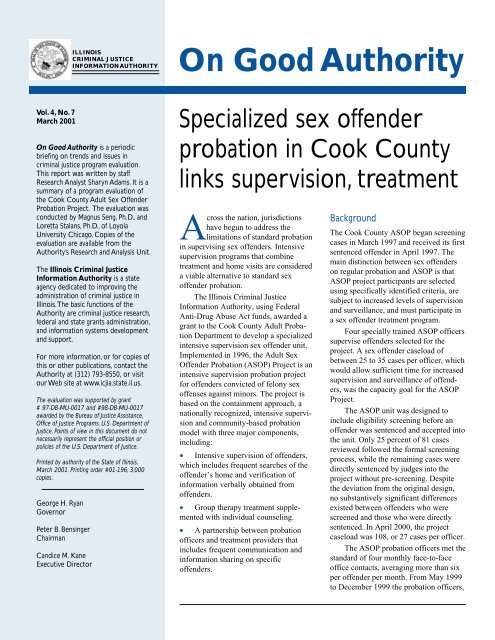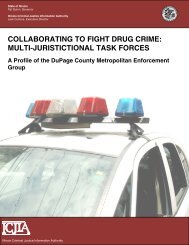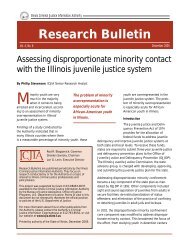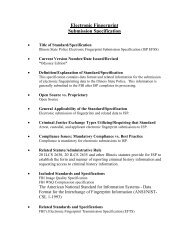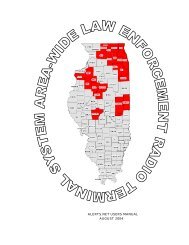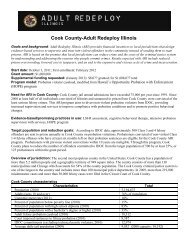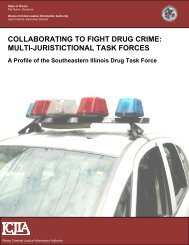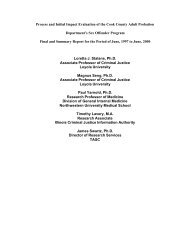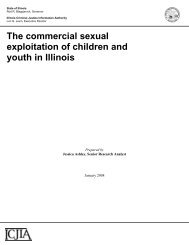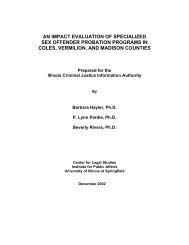Specialized sex offender probation in Cook - Illinois Criminal Justice ...
Specialized sex offender probation in Cook - Illinois Criminal Justice ...
Specialized sex offender probation in Cook - Illinois Criminal Justice ...
You also want an ePaper? Increase the reach of your titles
YUMPU automatically turns print PDFs into web optimized ePapers that Google loves.
Vol. 4, No. 7<br />
March 2001<br />
On Good Authority is a periodic<br />
brief<strong>in</strong>g on trends and issues <strong>in</strong><br />
crim<strong>in</strong>al justice program evaluation.<br />
This report was written by staff<br />
Research Analyst Sharyn Adams. It is a<br />
summary of a program evaluation of<br />
the <strong>Cook</strong> County Adult Sex Offender<br />
Probation Project. The evaluation was<br />
conducted by Magnus Seng, Ph.D., and<br />
Loretta Stalans, Ph.D., of Loyola<br />
University Chicago. Copies of the<br />
evaluation are available from the<br />
Authority’s Research and Analysis Unit.<br />
The Ill<strong>in</strong>ois Crim<strong>in</strong>al <strong>Justice</strong><br />
Information Authority is a state<br />
agency dedicated to improv<strong>in</strong>g the<br />
adm<strong>in</strong>istration of crim<strong>in</strong>al justice <strong>in</strong><br />
Ill<strong>in</strong>ois. The basic functions of the<br />
Authority are crim<strong>in</strong>al justice research,<br />
federal and state grants adm<strong>in</strong>istration,<br />
and <strong>in</strong>formation systems development<br />
and support.<br />
For more <strong>in</strong>formation, or for copies of<br />
this or other publications, contact the<br />
Authority at (312) 793-8550, or visit<br />
our Web site at www.icjia.state.il.us.<br />
The evaluation was supported by grant<br />
# 97-DB-MU-0017 and #98-DB-MU-0017<br />
awarded by the Bureau of <strong>Justice</strong> Assistance,<br />
Office of <strong>Justice</strong> Programs, U.S. Department of<br />
<strong>Justice</strong>. Po<strong>in</strong>ts of view <strong>in</strong> this document do not<br />
necessarily represent the official position or<br />
policies of the U.S. Department of <strong>Justice</strong>.<br />
Pr<strong>in</strong>ted by authority of the State of Ill<strong>in</strong>ois,<br />
March 2001. Pr<strong>in</strong>t<strong>in</strong>g order #01-196; 3,000<br />
copies.<br />
George H. Ryan<br />
Governor<br />
Peter B. Bens<strong>in</strong>ger<br />
Chairman<br />
Candice M. Kane<br />
Executive Director<br />
ILLINOIS<br />
CRIMINAL JUSTICE<br />
INFORMATION AUTHORITY<br />
On Good Authority<br />
<strong>Specialized</strong> <strong>sex</strong> <strong>offender</strong><br />
<strong>probation</strong> <strong>in</strong> <strong>Cook</strong> County<br />
l<strong>in</strong>ks supervision, treatment<br />
Across the nation, jurisdictions<br />
have begun to address the<br />
limitations of standard <strong>probation</strong><br />
<strong>in</strong> supervis<strong>in</strong>g <strong>sex</strong> <strong>offender</strong>s. Intensive<br />
supervision programs that comb<strong>in</strong>e<br />
treatment and home visits are considered<br />
a viable alternative to standard <strong>sex</strong><br />
<strong>offender</strong> <strong>probation</strong>.<br />
The Ill<strong>in</strong>ois Crim<strong>in</strong>al <strong>Justice</strong><br />
Information Authority, us<strong>in</strong>g Federal<br />
Anti-Drug Abuse Act funds, awarded a<br />
grant to the <strong>Cook</strong> County Adult Probation<br />
Department to develop a specialized<br />
<strong>in</strong>tensive supervision <strong>sex</strong> <strong>offender</strong> unit.<br />
Implemented <strong>in</strong> 1996, the Adult Sex<br />
Offender Probation (ASOP) Project is an<br />
<strong>in</strong>tensive supervision <strong>probation</strong> project<br />
for <strong>offender</strong>s convicted of felony <strong>sex</strong><br />
offenses aga<strong>in</strong>st m<strong>in</strong>ors. The project is<br />
based on the conta<strong>in</strong>ment approach, a<br />
nationally recognized, <strong>in</strong>tensive supervision<br />
and community-based <strong>probation</strong><br />
model with three major components,<br />
<strong>in</strong>clud<strong>in</strong>g:<br />
• Intensive supervision of <strong>offender</strong>s,<br />
which <strong>in</strong>cludes frequent searches of the<br />
<strong>offender</strong>’s home and verification of<br />
<strong>in</strong>formation verbally obta<strong>in</strong>ed from<br />
<strong>offender</strong>s.<br />
• Group therapy treatment supplemented<br />
with <strong>in</strong>dividual counsel<strong>in</strong>g.<br />
• A partnership between <strong>probation</strong><br />
officers and treatment providers that<br />
<strong>in</strong>cludes frequent communication and<br />
<strong>in</strong>formation shar<strong>in</strong>g on specific<br />
<strong>offender</strong>s.<br />
Background<br />
The <strong>Cook</strong> County ASOP began screen<strong>in</strong>g<br />
cases <strong>in</strong> March 1997 and received its first<br />
sentenced <strong>offender</strong> <strong>in</strong> April 1997. The<br />
ma<strong>in</strong> dist<strong>in</strong>ction between <strong>sex</strong> <strong>offender</strong>s<br />
on regular <strong>probation</strong> and ASOP is that<br />
ASOP project participants are selected<br />
us<strong>in</strong>g specifically identified criteria, are<br />
subject to <strong>in</strong>creased levels of supervision<br />
and surveillance, and must participate <strong>in</strong><br />
a <strong>sex</strong> <strong>offender</strong> treatment program.<br />
Four specially tra<strong>in</strong>ed ASOP officers<br />
supervise <strong>offender</strong>s selected for the<br />
project. A <strong>sex</strong> <strong>offender</strong> caseload of<br />
between 25 to 35 cases per officer, which<br />
would allow sufficient time for <strong>in</strong>creased<br />
supervision and surveillance of <strong>offender</strong>s,<br />
was the capacity goal for the ASOP<br />
Project.<br />
The ASOP unit was designed to<br />
<strong>in</strong>clude eligibility screen<strong>in</strong>g before an<br />
<strong>offender</strong> was sentenced and accepted <strong>in</strong>to<br />
the unit. Only 25 percent of 81 cases<br />
reviewed followed the formal screen<strong>in</strong>g<br />
process, while the rema<strong>in</strong><strong>in</strong>g cases were<br />
directly sentenced by judges <strong>in</strong>to the<br />
project without pre-screen<strong>in</strong>g. Despite<br />
the deviation from the orig<strong>in</strong>al design,<br />
no substantively significant differences<br />
existed between <strong>offender</strong>s who were<br />
screened and those who were directly<br />
sentenced. In April 2000, the project<br />
caseload was 108, or 27 cases per officer.<br />
The ASOP <strong>probation</strong> officers met the<br />
standard of four monthly face-to-face<br />
office contacts, averag<strong>in</strong>g more than six<br />
per <strong>offender</strong> per month. From May 1999<br />
to December 1999 the <strong>probation</strong> officers,<br />
– 1 –
on average, made more than the required<br />
number of office contacts. The f<strong>in</strong>d<strong>in</strong>gs<br />
for field visits rema<strong>in</strong>ed consistent<br />
throughout the two and one-half year<br />
evaluation period. Although ASOP<br />
<strong>probation</strong> officers had not conducted, on<br />
average, one field visit per <strong>offender</strong> <strong>in</strong><br />
any month dur<strong>in</strong>g the evaluation period,<br />
ASOP adm<strong>in</strong>istrators did establish a<br />
home check procedure with the <strong>probation</strong><br />
department’s Home Conf<strong>in</strong>ement Unit.<br />
The Home Conf<strong>in</strong>ement Unit, <strong>in</strong> the<br />
course of curfew checks, would enter the<br />
<strong>offender</strong>’s home to check for evidence of<br />
m<strong>in</strong>ors or the victims of their offense, as<br />
well as other <strong>in</strong>dications of high-risk<br />
behavior. About 175 home conf<strong>in</strong>ement<br />
checks were made of Phase I <strong>offender</strong>s<br />
and 50 checks were made of Phase II<br />
<strong>offender</strong>s each month.<br />
Treatment<br />
The <strong>Cook</strong> County ASOP project worked<br />
well <strong>in</strong> various areas. The unit provided a<br />
written list of the requirements for<br />
treatment evaluations to all treatment<br />
providers. The requirements state that the<br />
evaluations must be written, <strong>in</strong>tegrate all<br />
<strong>in</strong>formation, and <strong>in</strong>clude a polygraph<br />
exam<strong>in</strong>ation, an objective personality<br />
test, and an objective <strong>sex</strong>ual preference<br />
test. The ASOP unit also created a<br />
committee of therapists to create uniform<br />
criteria to judge progress <strong>in</strong> and successful<br />
completion of treatment. Additionally,<br />
the unit and therapists created<br />
standard policies on how to respond to<br />
noncompliance demonstrated <strong>in</strong> treatment,<br />
such as tard<strong>in</strong>ess, unexcused<br />
absences, and fail<strong>in</strong>g to complete<br />
treatment. The unit also requires that<br />
providers hold group therapy sessions<br />
that last a m<strong>in</strong>imum of 90 m<strong>in</strong>utes per<br />
week, and conduct one group therapy<br />
session a week and one <strong>in</strong>dividual<br />
counsel<strong>in</strong>g session twice a month.<br />
F<strong>in</strong>ally, the ASOP unit contracted with<br />
treatment providers throughout <strong>Cook</strong><br />
County to ensure that services are<br />
geographically accessible to <strong>offender</strong>s.<br />
Accord<strong>in</strong>g to monthly reports<br />
submitted by therapists, the average<br />
number of <strong>sex</strong> <strong>offender</strong> group therapy<br />
sessions scheduled per month was 3.71,<br />
slightly below the expected average of<br />
four. Of the 45 <strong>sex</strong> <strong>offender</strong>s studied who<br />
were treated by the two major treatment<br />
Offender treatment<br />
dimensions<br />
Table 1<br />
Therapist rat<strong>in</strong>gs on six dimensions related<br />
to <strong>sex</strong> <strong>offender</strong> treatment*<br />
Mean rat<strong>in</strong>g on first<br />
monthly report across<br />
<strong>sex</strong> <strong>offender</strong>s<br />
*Scale ranges from 1 to 10 and was developed by the project evaluators and treatment providers. Higher<br />
numbers <strong>in</strong>dicate more of the characteristic.<br />
Offenders demonstrated positive<br />
lifestyle changes by seek<strong>in</strong>g or<br />
obta<strong>in</strong><strong>in</strong>g employment. They also<br />
learned to manage their anger,<br />
were more emotionally open <strong>in</strong><br />
group therapy, and took more<br />
responsibility for their crimes.<br />
agencies, 12 attended every group<br />
therapy session, while one-third missed<br />
three or more. The average number of<br />
<strong>in</strong>dividual sessions attended by <strong>offender</strong>s<br />
was 1.25, slightly below the expected<br />
average of two, but more than one-half of<br />
the <strong>offender</strong>s did not miss any <strong>in</strong>dividual<br />
sessions.<br />
The monthly treatment reports<br />
therapists submitted also <strong>in</strong>dicated the<br />
occurrence of positive lifestyle changes,<br />
such as strengthen<strong>in</strong>g social relationships,<br />
ma<strong>in</strong>ta<strong>in</strong><strong>in</strong>g sobriety, and improv<strong>in</strong>g<br />
employment status. Offenders<br />
Mean rat<strong>in</strong>g on last<br />
monthly report across<br />
<strong>sex</strong> <strong>offender</strong>s<br />
Mean rat<strong>in</strong>g across<br />
all monthly reports<br />
and all <strong>sex</strong> <strong>offender</strong>s<br />
Participation<br />
5.57<br />
6.31<br />
6.12<br />
Commitment<br />
5.38<br />
6.22<br />
5.87<br />
Acknowledges<br />
personal responsibility<br />
for the offense<br />
Understands<br />
consequences of<br />
reoffend<strong>in</strong>g<br />
Will<strong>in</strong>g to disclose<br />
<strong>in</strong>appropriate <strong>sex</strong>ual<br />
behavior<br />
Accepts responsibility<br />
for harm caused to<br />
victims<br />
5.46<br />
6.52<br />
6.14<br />
5.93<br />
6.71<br />
6.53<br />
5.02<br />
6.22<br />
5.66<br />
4.98<br />
5.86<br />
5.52<br />
demonstrated positive lifestyle changes<br />
by seek<strong>in</strong>g or obta<strong>in</strong><strong>in</strong>g employment and<br />
by receiv<strong>in</strong>g a promotion. Offenders who<br />
made positive lifestyle changes also<br />
learned to manage their anger, were more<br />
emotionally open <strong>in</strong> group therapy, and<br />
took more responsibility for their crimes.<br />
In addition, <strong>offender</strong>s tended to improve<br />
over time on the six critical dimensions<br />
of treatment, measur<strong>in</strong>g an <strong>offender</strong>’s<br />
potential for recidivism and how well<br />
<strong>offender</strong>s are respond<strong>in</strong>g to treatment<br />
(Table 1). N<strong>in</strong>eteen of the 45 <strong>offender</strong>s<br />
did not show any positive lifestyle<br />
changes.<br />
Group comparisons<br />
The research design for the evaluation<br />
<strong>in</strong>cluded a control sample of <strong>sex</strong> <strong>offender</strong>s<br />
who were convicted of the same<br />
crimes as the ASOP sample and were<br />
sentenced to standard <strong>probation</strong>. Data<br />
was collected from 208 <strong>sex</strong> <strong>offender</strong>s on<br />
standard <strong>probation</strong> <strong>in</strong> <strong>Cook</strong> County and<br />
was compared to data collected on the<br />
ASOP <strong>offender</strong>s to determ<strong>in</strong>e the impact<br />
– 2 –
Characteristic with statistically<br />
significant difference<br />
Victim was<br />
member<br />
not a family<br />
Age of youngest victim<br />
of the project. Offenders <strong>in</strong> the control<br />
sample were convicted of aggravated<br />
crim<strong>in</strong>al <strong>sex</strong>ual assault, crim<strong>in</strong>al <strong>sex</strong>ual<br />
assault, or aggravated crim<strong>in</strong>al <strong>sex</strong>ual<br />
abuse, had committed an offense aga<strong>in</strong>st<br />
a m<strong>in</strong>or, and were sentenced to <strong>probation</strong><br />
between January 1993 and January 1997.<br />
Control sample data were obta<strong>in</strong>ed from<br />
<strong>probation</strong> department case files, however,<br />
the files generally did not <strong>in</strong>clude<br />
treatment <strong>in</strong>formation or detailed<br />
<strong>in</strong>formation about the offense.<br />
Accord<strong>in</strong>g to comparisons on<br />
variables that may affect recidivism, the<br />
ASOP sample and the control sample<br />
were similar on 20 characteristics, and<br />
differed on five characteristics. In terms<br />
of similarities, close to one-half of both<br />
the ASOP and control samples were<br />
never-married s<strong>in</strong>gle men and 28 percent<br />
of the ASOP sample and 36 percent of<br />
the control sample were married. Both<br />
groups were <strong>in</strong> their 30s, with a mean age<br />
of 32 <strong>in</strong> the ASOP sample and about 35<br />
<strong>in</strong> the control sample. About one-half of<br />
both samples were regularly employed <strong>in</strong><br />
the past (53 percent of the ASOP sample<br />
and 50 percent of the control sample) and<br />
were employed dur<strong>in</strong>g the evaluation (51<br />
percent of the ASOP sample and 67<br />
percent of the control sample). Also,<br />
more than 70 percent of the <strong>sex</strong> <strong>offender</strong>s<br />
<strong>in</strong> both samples lived <strong>in</strong> poverty at the<br />
time of the <strong>in</strong>take <strong>in</strong>terview, and roughly<br />
one-half of both samples failed to<br />
complete high school.<br />
The ASOP and control sample<br />
differed on these five characteristics:<br />
• Whether the <strong>offender</strong> was a family<br />
member of the victim.<br />
• The age of the youngest victim.<br />
• The number of prior arrests for<br />
misdemeanor crimes.<br />
• The number of prior arrests for any<br />
offense.<br />
• Whether an <strong>offender</strong> previously had<br />
been arrested for at least one offense but<br />
never had been convicted.<br />
ASOP <strong>offender</strong>s were more likely to<br />
have victimized a family member, and<br />
were more likely to have victimized a<br />
child between the ages of 2 and 8. Also,<br />
ASOP <strong>offender</strong>s were less likely to have<br />
been arrested previously for a misdemeanor,<br />
or for any offense, and less<br />
likely to have been arrested but not<br />
convicted of any offense (Table 2).<br />
Probation outcomes<br />
About 23 percent of ASOP participants<br />
and 18 percent of control sample <strong>offender</strong>s<br />
were arrested dur<strong>in</strong>g their <strong>probation</strong><br />
period. Just more than 5 percent of ASOP<br />
<strong>offender</strong>s were arrested for and/or<br />
convicted of a <strong>sex</strong>-related offense,<br />
compared with just more than 3 percent<br />
of control sample <strong>offender</strong>s. Eighteen<br />
ASOP <strong>offender</strong>s were arrested at least<br />
once while on <strong>probation</strong> – four of these<br />
<strong>offender</strong>s were charged with a new <strong>sex</strong><br />
offense. Of 38 control <strong>offender</strong>s arrested<br />
at least once while on <strong>probation</strong>, seven<br />
were charged with a new <strong>sex</strong> offense.<br />
Both ASOP and control sample <strong>offender</strong>s<br />
were arrested for battery, domestic<br />
Table 2<br />
Characteristic differences between<br />
ASOP and control samples<br />
ASOP sample<br />
(78 <strong>offender</strong>s)<br />
Control sample<br />
(208 <strong>offender</strong>s)<br />
33%<br />
55%<br />
2 - 8<br />
42%<br />
11%<br />
9 - 12<br />
26%<br />
45%<br />
12<br />
- 17<br />
29%<br />
44%<br />
18<br />
or older<br />
3%<br />
0<br />
Previously arrested<br />
for a misdemeanor<br />
Previously arrested<br />
for any crime<br />
Arrests and convictions<br />
25%<br />
44%<br />
36%<br />
59%<br />
P rior arrests, no convictions<br />
22%<br />
41%<br />
No prior arrests or<br />
convictions<br />
78%<br />
59%<br />
*Valid percentages represented. Denom<strong>in</strong>ator of 28 or 208 was adjusted to take <strong>in</strong>to account miss<strong>in</strong>g data.<br />
battery, drug possession, and burglary,<br />
among other charges. ASOP participants<br />
were arrested much earlier dur<strong>in</strong>g their<br />
<strong>probation</strong> – two times faster than<br />
<strong>offender</strong>s on standard <strong>probation</strong>. On the<br />
average, ASOP <strong>offender</strong>s were first<br />
arrested after seven months of <strong>probation</strong><br />
whereas control <strong>offender</strong>s were arrested<br />
after one year and four months of<br />
<strong>probation</strong>. About the same percentage of<br />
ASOP <strong>offender</strong>s and control <strong>offender</strong>s<br />
absconded for a period of time. As a<br />
result, arrest warrants were issued aga<strong>in</strong>st<br />
them (21 percent and 18 percent,<br />
respectively).<br />
ASOP <strong>offender</strong>s and control <strong>offender</strong>s<br />
differed the most <strong>in</strong> three outcome<br />
variables:<br />
• The number of <strong>probation</strong> revocations<br />
(26 percent of ASOP sample and 11<br />
percent of control sample).<br />
– 3 –
• The number of unsatisfactory<br />
<strong>probation</strong> term<strong>in</strong>ations (26 percent of<br />
ASOP sample and 17 percent of control<br />
sample). While <strong>probation</strong> was revoked<br />
from ASOP <strong>offender</strong>s who were term<strong>in</strong>ated<br />
unsatisfactorily, 14 control sample<br />
cases (almost 7 percent of the sample)<br />
were term<strong>in</strong>ated unsatisfactorily without<br />
repercussion.<br />
• The number of <strong>probation</strong> violation<br />
petitions filed (59 percent of the ASOP<br />
sample received violation petitions, as<br />
did 42 percent of the control sample).<br />
These differences may have been the<br />
result of the number of <strong>probation</strong><br />
conditions on ASOP <strong>offender</strong>s and the<br />
strictness of ASOP <strong>probation</strong> officers.<br />
ASOP <strong>offender</strong>s are faced with a larger<br />
number of more restrictive <strong>probation</strong><br />
conditions that are readily enforced by<br />
their <strong>probation</strong> officers. ASOP officers<br />
also were three times more likely to file a<br />
violation of <strong>probation</strong> petition than were<br />
standard <strong>probation</strong> officers. Control<br />
sample <strong>probation</strong>ers often committed two<br />
or three non-<strong>sex</strong>-related offenses before a<br />
violation of <strong>probation</strong> petition was filed.<br />
Conclusion and recommendations<br />
Evaluators found that Adult Sex Offender<br />
Probation Project was well implemented.<br />
The project was under effective management<br />
and was improv<strong>in</strong>g its partnerships<br />
with therapists and its surveillance<br />
efforts.<br />
ASOP <strong>probation</strong> officers met faceto-face<br />
office contact standards, required<br />
<strong>offender</strong>s to keep logs of their time,<br />
developed graduated sanction guidel<strong>in</strong>es,<br />
and established strict and appropriate<br />
responses to <strong>offender</strong> noncompliance.<br />
The <strong>Cook</strong> County ASOP project also<br />
showed superior performance <strong>in</strong> obta<strong>in</strong><strong>in</strong>g<br />
quality treatment evaluations,<br />
meet<strong>in</strong>g treatment frequency standards,<br />
seek<strong>in</strong>g treatment agencies <strong>in</strong> all geographical<br />
areas of the county, and<br />
attempt<strong>in</strong>g to obta<strong>in</strong> uniform quality<br />
treatment from several agencies. Despite<br />
successful implementation and quality<br />
treatment, the project was still unable to<br />
meet field visit requirements. Evaluators<br />
offered the follow<strong>in</strong>g recommendations:<br />
• Home Conf<strong>in</strong>ement Unit visits<br />
should rema<strong>in</strong> part of the field visit<br />
structure, but should not substitute for the<br />
ASOP officer-conducted field visits.<br />
• Officers conduct<strong>in</strong>g searches should<br />
have detailed knowledge of high-risk<br />
behaviors <strong>in</strong> each case.<br />
• Some consideration should be given<br />
to assign<strong>in</strong>g all <strong>sex</strong> <strong>offender</strong>s to an<br />
expanded ASOP unit or <strong>in</strong>creas<strong>in</strong>g<br />
supervision practices of <strong>sex</strong> <strong>offender</strong>s <strong>in</strong><br />
the standard <strong>probation</strong> unit.<br />
• The project should establish uniform<br />
criteria for determ<strong>in</strong><strong>in</strong>g treatment<br />
progress across agencies, and communicate<br />
the conditions of treatment and<br />
<strong>probation</strong> to each <strong>offender</strong> <strong>in</strong> a meet<strong>in</strong>g<br />
with the therapist, <strong>probation</strong> officer, and<br />
<strong>offender</strong>.u<br />
ILLINOIS<br />
Crim<strong>in</strong>al <strong>Justice</strong> Information Authority<br />
BULK RATE<br />
U.S. POSTAGE<br />
PAID<br />
CHICAGO, IL<br />
PERMIT NUMBER 4273<br />
120 S. Riverside Plaza, Suite 1016<br />
Chicago, Ill<strong>in</strong>ois 60606<br />
312-793-8550, TDD: 312-793-4170, Fax: 312-793-8422<br />
www.icjia.state.il.us<br />
– 4 –


